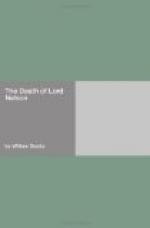A little before sunset the Euryalus communicated intelligence by telegraph, that “the Enemy appeared determined to go to the westward.” His Lordship upon this ordered it to be signified to Captain Blackwood (of that ship) by signal, that “he depended on the Euryalus for keeping sight of the Enemy during the night.” The night signals were so clearly and distinctly arranged by His Lordship, and so well understood by the respective Captains, that the Enemy’s motions continued to be made known to him with the greatest facility throughout the night: a certain number of guns, with false fires and blue lights announced their altering their course, wearing, and making or shortening sail; and signals communicating such changes were repeated by the look-out ships, from the Euryalus to the Victory.
The Enemy wore twice during the night: which evolution was considered by His Lordship as shewing an intention, on their part, of keeping the port of Cadiz open; and made him apprehend that on seeing the British Fleet, they would effect their retreat thither before he could bring them to a general action. He was therefore very careful not to approach their Fleet near enough to be seen by them before morning.
The British Fleet wore about two o’clock in the morning; and stood on the larboard tack with their heads to the northward, carrying their topsails and foresails, and anxiously expecting the dawn of day. When that period arrived, the Combined Fleets were distinctly seen from the Victory’s deck, formed in a close line of battle ahead on the starboard tack, standing to the south, and about twelve miles to leeward. They consisted of thirty-three ships of the line; four of which were three-deckers, and one of seventy guns: the strength of the British Fleet was twenty-seven ships of the line; seven of which were three-deckers, and three of sixty-four guns. Lord Nelson had, on the 10th, issued written Instructions to the Admirals and Captains of the Fleet individually, pointing out his intended mode of attack in the event of meeting the Enemy;[3] and now, previously to appearing himself on deck, he directed Captain Hardy to make the necessary signals for the order and disposition of the Fleet accordingly.
His Lordship came upon deck soon after day-light: he was dressed as usual in his Admiral’s frock-coat, bearing on the left breast four stars of different orders which he always wore with his common apparel.[4] He displayed excellent spirits, and expressed his pleasure at the prospect of giving a fatal blow to the naval power of France and Spain; and spoke with confidence of obtaining a signal victory notwithstanding the inferiority of the British Fleet, declaring to Captain Hardy that “he would not be contented with capturing less than twenty sail of the line.” He afterwards pleasantly observed that “the 21st of October was the happiest day in the year among his family,” but did not assign the reason of this.[5] His Lordship had previously entertained a strong presentiment that this would prove the auspicious day; and had several times said to Captain Hardy and Doctor Scott (Chaplain of the ship, and Foreign Secretary to the Commander in Chief, whose intimate friendship he enjoyed), “The 21st of October will be our day.”




